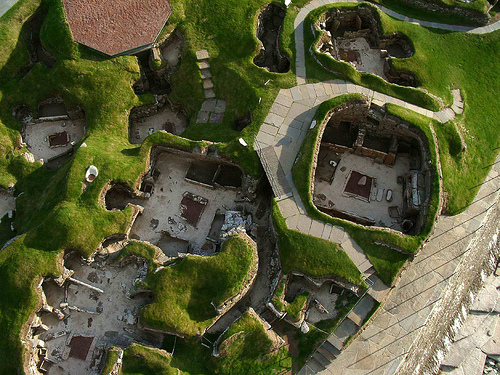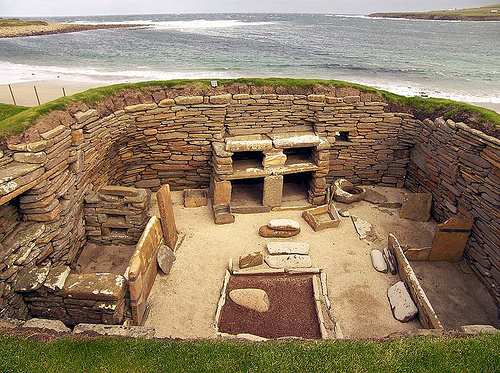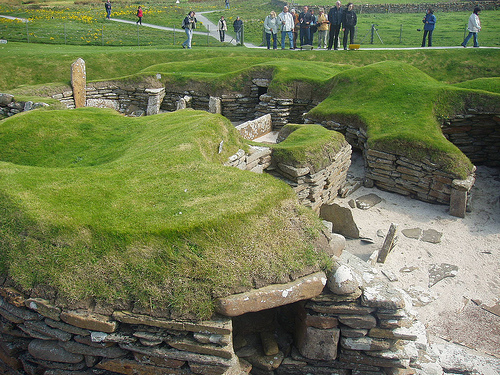

Location: Orkney Scotland Map
Open: Apr- Sept: (9:30am- 5:30pm)
Oct- Mar: 9:30am- 4:30pm
Entrance Fee: Apr- Oct: Adult £6.90, Child £4.10
Nov- Mar: Adult £5.90, Child £3.50

Skara Brae Archaeological Site is located on the Bay of Skaill on the western coast of mainland Orkney, Scotland. Skara Brae Archaeological Site is a remarkably preserved settlement from Neolithic times (3100- 2500 BC) that is considered to be the best preserved site from the time period. Builders used stone to build furniture, seats, storage boxes and cupboards thus rooms are at the same condition as it was 5000 years ago. Due to its importance and great condition Skara Brae was given a status of UNESCO World Heritage Site. The only thing that is missing are the roofs that were made from wood or whale bone and covered by grass, turf thatch and probably peat to prevent heat loss. Some dwellings have been reconstructed to give an idea what it looked like in the past. Houses are dug out to preserve heat and usually measures at 40 square meters.
No one knows for sure why the people abandoned this site. Probably it was due to weather change that became wetter and colder or maybe due to sea erosion that undermined several buildings. Whatever the cause might be inhabitants of Scara Brae left a time capsule of their daily lives. It was re- discovered in 1850 after a massive storm that killed over 200 people in the area and washed away upper soil levels thus exposing the settlement. William Watt of Skaill, local laird, organized first archeological digs on the site, but it didn't last long. Scara Brae was abandoned until the site was hit by marauders in 1913 and another storm. This time party uncovelered ancient village was damaged by nature's wrath. First professional digs and preservation were undertaken by Professor Vere Gordon Childre from the University of Edinburgh in 1927.

After a violent storm in Scotland in 1850 that claimed
the lives of over 200 people, some buildings were discovered under a
dune. First, local landowner Graham Watt, the 7th Laird of Skaill, began
investigations into four houses, which ceased in 1868. The results of
the excavation were presented by George Petrie. Excavations by the
antiquary James Farrer remained largely undocumented. Further measures
have been taken since 1924, when the site was again threatened by storm
surges. Excavations took place between 1928 and 1930 under the
supervision of Gordon Childe of Edinburgh University. The settlement was
initially attributed to the Picts and dated to the late Bronze Age. An
age determination using the radiocarbon method was carried out in the
early 1970s.
Skara Brae is considered to be the best preserved
Neolithic settlement in Europe. Skara Brae is therefore also called the
"Pompeii of Scotland". In 1999 Skara Brae was declared a World Heritage
Site by UNESCO as part of the heart of Neolithic Orkney. In 2019, Skara
Brae was visited by around 115,000 people.
The rectangular houses are built of stone, as wood (the common Neolithic building material) was rare in Orkney. The shape of the nine houses is also known from the Rinyo site of the same date and the earlier Barnhouse.
Cattle, sheep or goats and pigs were kept around Skara Brae, barley was grown and bread was probably also baked, as in the contemporaneous Rinyo on Rousay. The Arl (a simple plough) was already known. In addition, the inhabitants lived from game (deer were apparently brought to the islands from the mainland), coastal fishing (cod), from oysters, lobsters, mussels and seabirds or their eggs and the secondary products of livestock farming (cheese, milk). A workshop was found at Skara Brae where local stones were processed, such as into Carved Stone Balls, five specimens of which have been found there. Findings of hematite originating from Hoy indicate that there was exchange among the islands of the archipelago.
The botanist Joseph Banks excavated tombs at the Links of Skail in 1772. In the 1860s, the Skara Brae Buddo was discovered by William G. Watt in the excavation of the stone alcove in House 3 of the Neolithic village.
In some episodes of the RPG epic Ultima, Skara Brae is
an independent island west of the main land "Britannia".
In the
computer role-playing game The Bard's Tale, Skara Brae, set in a
hypothetical Middle Ages, forms the main plot
The name also refers to
a former traditional Irish folk band of the 1970s, active between 1970
and 1971 and releasing a single album of Irish language songs
In the
film Indiana Jones and the Kingdom of the Crystal Skull, Professor
Indiana Jones teaches an archeology class on Skara Brae